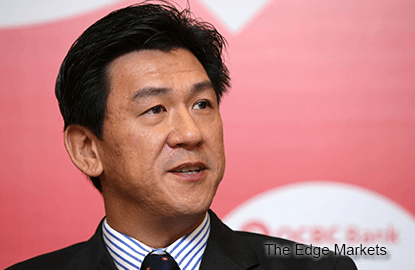
BANKS will remain the go-to place for most people to have their financial needs met, despite the wide variety of free financial advisory services available today, says Hong Leong Bank Bhd’s chief operating officer for personal financial services Charles Sik.
“Banks have an innate advantage, that is, we understand our customers a lot better [than the competition]. If you are our customer, and you have your deposits and loan products with us, it means that we have a better understanding of you than anyone else in the market,” he tells Personal Wealth.
“We know that internet start-ups are offering similar solutions — those new age personal financial models out there, where you can put in some information and have a chart tell you how fast you can retire and so on. But the disadvantage is that they don’t really know or understand what kind of portfolio you have,” he points out.
“We don’t have to skirt around the issue to ask, ‘How much money do you really have? What’s your income like?’, because we know your income from your credit and we know how much deposit you have.”
Banks’ business model, which used to be more credit-centric, has evolved to provide other services such as wealth advisory and retirement planning. Calling this an “advisory model”, Sik believes that while internet portals can compete with banks in this space, banks are able to offer products as well as advisory services. Banks are also governed by regulations.
“We are heavily regulated — we cannot just do anything we want. We are regulated not only by Bank Negara Malaysia, but also the Securities Commission Malaysia when it comes to the products we sell. We are also regulated by the insurance industry [for insurance products]. In that sense, we are more credible. We can’t just open a website today and close it down tomorrow,” he says.
“The start-up does not make money by selling products, but from advertising revenue. It sells its data to somebody else. Banks can’t do that. We have to think of privacy and customer data integrity. As our customer, you are protected by privacy laws because the regulators make sure we do that. As for whether we are better [at advisory services], that’s for the consumer [to decide].”
The difference between banks is really in the execution of that customer process and their trust model, especially in the aftermath of the global financial crisis.
“Investing one’s money is really a big leap of faith for the common man, hence as products become more complex and varied, people need a bank that they can trust to help them navigate through some of these decisions,” Sik says.
“Since the global financial crisis, that trust is becoming a scarce commodity. Hence, when I talk about a trust model, it is really about what kind of track record, transparency, expertise and customer protection philosophy the bank promotes. We have a bigger responsibility, now more than ever, as an institution to build back that trust.”
Moving towards wealth management
Today, a bank’s customers can expect to have all their financial needs met at the bank, Sik explains.
“If you look at where banking is today, it is really about focusing on consumers and what they want. We try to figure out a platform to provide consumers with an idea of what we are trying to do,” he says.
For example, a bank’s typical wealth management model may include an advisory model to encompass all of its offerings, such as research outlook reports, products, product specialists (such as for unit trusts or foreign exchange), and a relationship manager.
“I think banks have become more sophisticated as more investment products and asset classes are introduced.”
Sik should know, as his banking career dates back to 2000, when regulators were just starting to allow banks to sell wealth management products to the masses. Sik began his career with Citibank, where he eventually became wealth management product director. Later, he moved to OCBC Bank to be head of consumer financial services.
“The first regulations were on unit trust distribution, when banks were appointed institutional unit trust distributors. The regulators on the insurance side later allowed us to distribute bancassurance,” he says.
“So, banks started to look at this as a new area for fee income. This was the start of the wealth management business for banks.”
The move towards wealth management came about when regulatory tightening, in the form of Basel III requirements, forced banks to beef up their capital reserves, Sik says.
“Banks now have less leverage in terms of the capital they put in versus the amount they can lend. Because of the squeeze, capital became more expensive and lending margins did not commensurate with the risk of putting capital in. Most banks then went into businesses that didn’t require capital, such as the fee income business.”
Sik acknowledges that banks today are targeting high net worth individuals, who are seen as more sophisticated than their retail counterparts. When asked whether banks should rethink the way they segregate their customers — by investor knowledge/sophistication rather than net worth — he says the high net worth segment remains a priority even though there might be very knowledgeable investors in the retail segment.
He agrees that banks should reconsider their segregation strategy, but hastens to add, “One should understand that there is a need to be able to deliver the right solution at the right cost. For example, I don’t mind having a team of specialists interface a conversation with a high net worth customer who makes huge investments, versus someone who has high knowledge but is probably less able to invest.”
This article first appeared in Personal Wealth, The Edge Malaysia Weekly, on June 22 - 28, 2015.
Save by subscribing to us for your print and/or digital copy.
P/S: The Edge is also available on Apple's AppStore and Androids' Google Play.